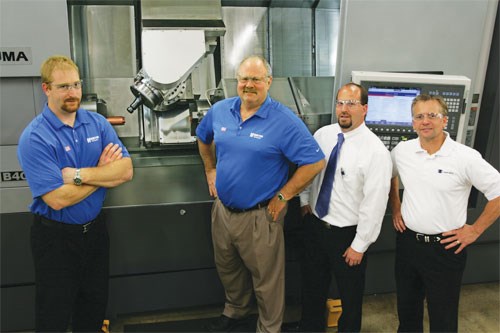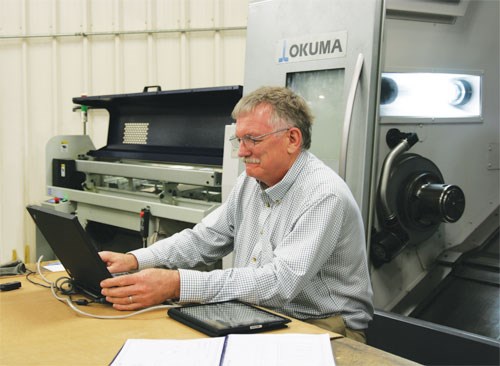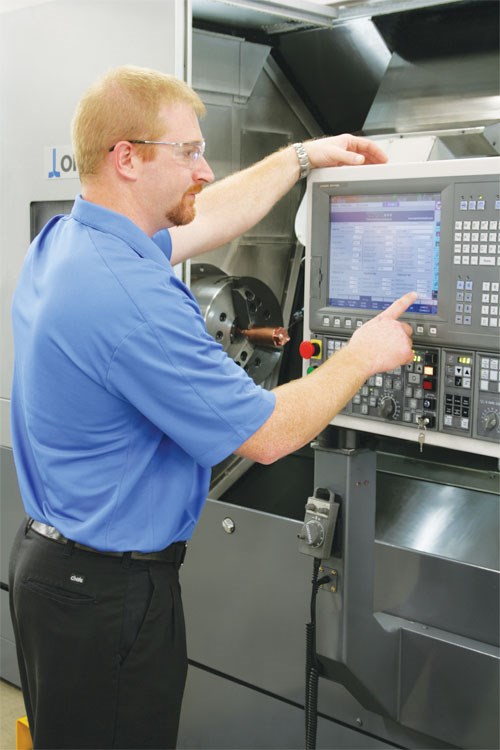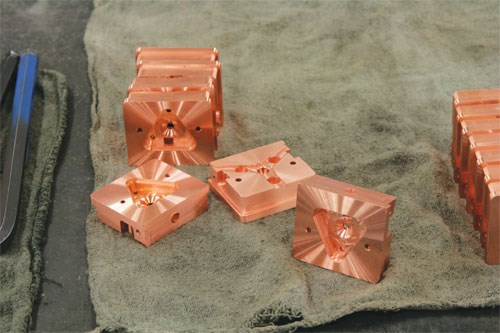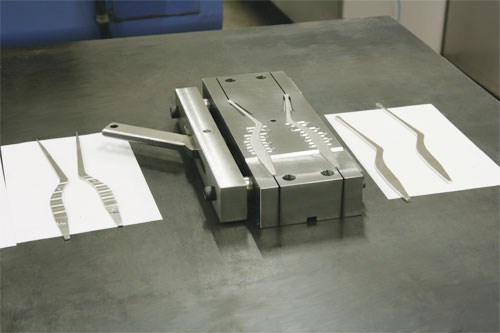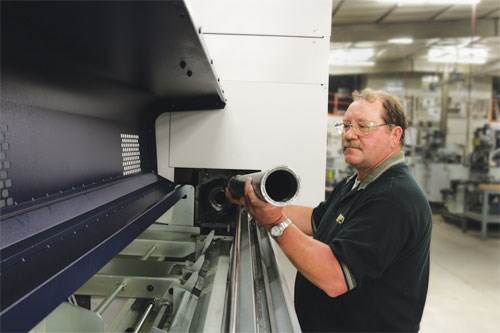Connecting the Technologies
This Missouri shop uses new advances in machine to machine communications to achieve its goals of lights out manufacturing and quick changeover.
“Imagine it,” says Herb Homeyer, president of Homeyer Tool and Die Company. “The technician loads the feeder with bars and goes home. We have provided him with internet access, and at 8:30 or 9 p.m., he can fire it up and log onto his machine to make sure everything is still good.” As his excitement grows, he says, “We’re not fully there yet, but these are our goals.” Achieving goals is one of his specialties.
In the beginning, with the help of his wife Lisa and other family members, Mr. Homeyer set up shop in a rented 4,200 square-foot space down the road from where he does business today. Later, he would lease another 2,000 square feet in the original building. Eventually, with the shop busting at its seams, Mr. Homeyer broke ground on his own 12,000 square-foot building in 1996. Within 2 short years, they would expand by adding an additional 4,000 square feet to the new building. Expansions in 2005 and 2008 brought the total space to 26,000 square feet.
Mr. Homeyer has a mission for his 20-year-old shop: to integrate each machine in his fleet of 22 Okuma lathes into an efficiency network. “We feel that the technology is going to take us there. With the THINC system and Edge Technologies’ Cogent interface, the bar feeder and the Okuma Multus machine is creating lights-out production possibilities we didn’t have before,” Mr. Homeyer explains.
The Lights-Out Team
Mr. Homeyer is not timid about investing in new technologies. His favorite saying is about the need for the latest innovations that can help keep him ahead of the competition: “If you’re not at the table, you’re gonna be on the menu.”
Connecting the technologies is the way Mr. Homeyer describes his motivation to pull together an advanced line-up of equipment and a knowledgeable group to put it to its best use. For his latest achievement, Herb assembled “The Team,” which includes General Manager Joe Kluba, Nick Berilla, a sales engineer for Hartwig Inc., a machine tool dealer in St. Louis, and Rick Bauer, general manager of Edge Technologies. The assigned task is to give Mr. Homeyer the most productive five-axis lathe and bar feeder combination for lights-out production.
The Okuma Multus B400-W is a five-axis lathe with a subspindle and features Okuma’s THINC OSP control. It features the Collision Avoidance System software, which can run the entire machining simulation and catch potential collisions before they create scrap.
As impressive as Mr. Homeyer thinks the Okuma B400-W lathe is, it’s the THINC software that allows Edge Technologies’ newly released Cogent interface software to fully connect the Rebel 102 Servo bar feeder to the lathe’s control system. This latest development is the culmination of months of Edge’s software development to add connectivity to the bar feeder/lathe relationship.
Now the operator can fully operate the bar feeder at the lathe’s controller. As the interface operates, a full set of control screens developed specifically for the Rebel 102 Servo are displayed on Okuma’s control screen, allowing the operator to view and control all of the bar feeder functions.
Martin Humphries, Edge Technologies’ engineering and product development manager, is a 42-year veteran developing software for the industry. “He has created for us an interface that others have only attempted,” Mr. Bauer says. “Edge is the only bar feed company with an interface like this functioning in the field.”
Mr. Humphries wrote a bar feeder interface especially for the Okuma control. Called the Cogent system, it watches the lathe to see what part program is running and will automatically run the proper feeder program. It can also look at the part program and add feeder commands into the lathe’s part program. There will also be enhanced debugging. The Cogent system will also send error codes to an off-site operator for easy fixes. Edge technical support via an internet connection is available: Mr. Humphries can take control of the feeder to fix issues and add upgrades from his desk in St. Louis.
The system is intuitive and has the capability to shave off seconds from the cycle time by monitoring feeder programs and making them more efficient. “An embedded computer in the bar feeder runs XP embedded software that will know how to talk to our software and any of our feeders. Also, just by adding a tablet computer to older lathes, the Cogent system will offer full functionality,” Mr. Humphries says. “It will even watch the lathe and send an e-mail to an operator if the lathe shuts down.”
THINC makes the Okuma control API (Application Programming Interface) available to their partners, making this development possible. The alliance between Edge and Okuma is due in part to Edge Technologies’ membership in Partners in THINC, which is a concept offering integrated solutions and a one-stop-shop designed to streamline current manufacturing processes, improve capabilities or explore advanced manufacturing options. “The connectivity between THINC, Edge and the Ethernet connection bridges those things together. When this is successful, you will build value,” Mr. Barilla says.
Now, Mr. Homeyer’s goal is to have all of his 22 Okuma machines on the THINC interface to be able to take advantage of Edge Technologies’ advancement on his bar-fed machines and to eventually “connect” the entire shop.
A Square Part from a Round Bar
As an example of Mr. Homeyer’s influence on process improvements, Mr. Kluba reminisces about the innovative thought process that brought them to the setup for the part that now runs on the new Okuma/Edge combination—a square laser component with intricate, high tolerance work. “We moved one of our jobs to a Swiss, and it was a square part; we turned it down from round bar.” Mr. Homeyer starts thinking and then says, “Why can’t we do that with this part or that part?”
Previously, this part went through five steps, machining blanks on a vertical with four-sided tombstones and milled and deburred. Now, Homeyer Tool and Dye runs round barstock into the Okuma multitasking lathe with an Edge Rebel 102 Servo feeder that can handle the large bars easily. Now they get the parts off complete.
Mr. Homeyer discusses how the economy affected his production on this part. “The bottom fell out of market in 2009. It went down 55 percent. But it’s coming back, or I should say, it’s already back now. And with our new bar feed with the interface, we are ready for it.”
Flying
Mr. Homeyer now owns 22 Okumas, and he likes to keep his machines current. “When they get to be 10 years old, I get rid of them and upgrade,” he explains. “Our goal is to have all new controllers in here, so we can have everything tied together. I don’t want to have a link that is broken because one machine is using old technology.”
When asked why there are all Okumas in the shop, Mr. Homeyer asks a question of his own. “You know who the most successful airline is?” Southwest. “Right,” he says. “Know why?” On-time departures. “Partly, but another reason is that they use one airplane—the 737. The staff comes cross-trained; all crews can fly all the planes. All the parts fit all planes. There’s no waiting on the tarmac for a special crew or a special part. They can keep the planes in the air.”
Like Southwest Airlines, Mr. Homeyer has a staff that can work any machine tool in the shop, which is a definite plus. “All of our controllers are understood by everyone here,” the company says. “In other shops, people say, ‘Jimmy knows how to run that, and Billy knows that machine there.’ Our people can switch to any machine at any time. When I read that article about Southwest Airlines, it just clicked in my mind. Same crews, same training, same fuel hook-ups, and so on.”
What Labor Cost?
Mr. Homeyer is the chapter president for the NTMA. He had just returned from Washington, D.C. where he and other members were up on Capitol Hill meeting with Congress members and discussing U.S. manufacturing issues.
“We were talking with a state representative on import issues, and I told him, ‘We can’t compete with China, India, Brazil, Vietnam using reduced labor (cost). We need to compete with zero labor (cost). Unmanned, lights-out technology equals zero labor cost. It will take an investment in new technologies across the board.’” He insists that the way for American manufacturers to compete with other businesses of the world is a philosophy of modern automation.
“We would like to achieve as much lights-out production as we do with operators,” he says. There are 8 hours of manned and 8 hours of unmanned production per day. “We can do it. I’ve got two wire EDMs with robotic loaders for those lights-out hours. You need to go with robotic load,” Mr. Homeyer says.
Skin the Cat
Not long ago, while looking at a set of forceps used to cauterize blood vessels during micro surgery for ophthalmology and neurology, Mr. Homeyer asked himself one of those “what if” questions. The answer: Stamp the part, then machine the grooves and tips rather than machine the whole part.
The result was a significant savings. “We knew it was very attractive to the customer. When we gave them the price, they started looking at their watches wondering when we could get started,” Mr. Homeyer jokes. “There is more than one way to skin a cat, but there is definitely one best way.”
The Tool & Die Guy
Mr. Homeyer started out as a tool and die maker, and for many years, he honed his skills working with close tolerances, doing very accurate work creating progressive dies.
“He knows how to figure the processes out. He can just see the solution,” Mr. Barilla says. “He brings all these various machining techniques and know-how into play. He’ll take a Swiss machine and wire EDM and maybe a waterjet or a press break and bring it all together to make a part. Who else can do that?”
Mr. Homeyer started 13 years ago with one customer, and by improving the process with different machines, processes and some lights-out production, he lowered his customer’s cost through the years. “Today, we sell this part to them for a third of the cost it was when we started. I have approached them and told them if they order larger quantities, I can reduce the cost even more. We could probably take it down to a fifth of the cost,” Mr. Homeyer boasts. The largest cost is an outside vendor for electron beam fusion gold plating or e-beam welding as it’s also called. “It was developed by Germans in World War II for their nuclear program,” he adds.
He has a variety of cutting and assembly machine tools to give the company the flexibility to be creative and keep the work in-house. In 2006 or 2007, Mr. Homeyer had issues getting some outside vendors to deliver in time to meet his customer’s demands. He didn’t hesitate. “I couldn’t get my suppliers to deliver quick enough. If the deadline was 8 weeks, I might get it in 10. So I brought in the press break to meet delivery times our customers require.”
About 70 percent of the company’s work is local, with much of it coming from firms in the St. Louis marketplace. The remainder of the work comes from all across the U.S. “We have American companies that have facilities in Mexico, and there is one of our parts for an American company that is shipped to China for assembly, then back to the U.S.,” says Mr. Kluba, Homeyer’s GM.
According to their customer, the Chinese can’t make the part to specifications because the tolerances are too close. They can’t make it for the price Mr. Homeyer can. Mr. Kluba explains, “It’s a rectangular part, but we run it on a Swiss machine and turn it down out of round stock, and we run lights out.”
Absolutely, Positively One Hour
As with the use of the Cogent system to gain lights-out production efficiencies, the shop is currently in the process of creating a streamlined setup procedure. The long-term focus is to drastically cut time on all setups. The company runs 3,000 to 5,000 quantity jobs, but the majority of its jobs are 20 to 100 parts. “It’s all these guys do, setup after setup. You need flexible machine tools in cases like this,” Mr. Bauer says. “Within 2 years, no matter how massive the setup is, we want to make it so it never takes more than 1 hour,” Mr. Homeyer states.
He is trying to initiate that goal now. Currently, the company has technicians on individual teams who are focusing on certain portions of the process throughout the flow. They are looking to where they can capture external setup time, such as when they can start the job by keeping close tabs on outside vendor deadlines. “We not only look at when it’s due, but when we can start,” Mr. Kluba says. Then the team looks closely at the scheduling of jobs and availability of machines as well as the internal setup time, dissecting every move made to complete the process.
“We’ve made huge leaps and bounds toward the goal with training our people and getting them oriented to what our objective is,” Mr. Kluba says. “Our lean manufacturing people spend a lot of time educating our team in what they are required to do and what needs to be done to reach the 1-hour goal.”
“We look at our equipment and internal setup and try to enhance the methods used to improve our setups,” Mr. Homeyer says. “To achieve success, it’s going to be all about the training.”
Lean Baby Lean
The Homeyer team is taking on the task alone. “We don’t have an outside consultant. Maybe we are muddling our way through, but we are doing it ourselves,” he says. To cut those minutes and seconds out of the process, he is open and honest about his role. “Where do we start? This office. I tell anyone, if you go through your office it’s probably the most inefficient area. There is no value streaming map. Map a value stream through your office.”
First, he explains the basic process in the office. “When our POs come in, Jennifer takes them to Martin, he does what he has to do, they go to Joe and he does what he has to do, they go to purchasing, then they go to quality, then to programming and they’re out.”
Then he explains the new process that has been implemented to speed things up. “Each one of these stations has a clock run on it, so all of them are timed.” The timed progress station is a function of the company’s MRP system. “You’ll see people who used to sit on stuff, but now it’s like a hot potato. They get their work done, and it’s gone,” he says.
But the clock is not used as a club. “It’s not a matter of time. The clock is there as a guide. If we look at this month, and it was in purchasing for 1.2 days, and next month it is in purchasing for 1.4 days, you must go back and find out why it took an extra 0.2 days in purchasing,” Mr. Homeyer explains. For instance, the purchasing agent might have had a problem with a vendor, then there may be a way to fix the issue. “That’s all I want to know,” he says. The outcome was impressive and immediate. “The results are mind-bending to us. But, then again, it’s not because of the clock. It’s because they now have direction.”
In his earlier research, Mr. Homeyer found an article that impressed him, and once again, he absorbed it and made it a part of the culture. Each employee expects that the others should know what they have to do in their work day and vice versa. The clock helps get everyone more involved, and they understand what others have to go through. It promotes cooperation and better results.
No Debt
Mr. Homeyer has always prided himself on fully owning each of his machines by paying cash, until recently. “We survived all these years without borrowing any money. Well, we borrowed money for one machine—the new Okuma—only because I didn’t feel like draining my cash reserves,” he says.
Many machine tool purchases require an accounting of how that machine will be paid for, down to the last dollar, before any PO is issued. Mr. Homeyer believes that method is folly. “I don’t buy like that. Me? Try to do a capital equipment justification to buy one machine? I would be better off putting my money in a savings account.”
When asked about how he justifies his decision to purchase a machine, like perhaps his new Okuma, his retort makes it clear. “$535,000 for a machine? Is there a justification for that? No. You have to have the passion for it.”
However, Mr. Homeyer, the optimist, does have a plan. To him, not investing in the technology is a losing proposition. He believes the work won’t come his way if the tools are not in hand. He counts on this year’s work to pay for next year’s newly added technology. Mr. Homeyer illustrates his point by marking off a timeline on his desk. “I can’t look at one job that has to get the machine paid off. I can’t justify it that way. I have to look at that one job as a means for me to get to the next stage.”
Pay Attention
“Paying attention to what’s available out there— looking, researching, reading—is important,” Mr. Homeyer says. “For example, if you’re a competitor and you give me a tour, I don’t care who you’re doing work for, I’m not interested in your part prints—I’m looking at your operation. A lot of our lean ideas came from one of our member companies in Florida who gave us a tour. It was a 110-man shop in a building smaller than ours. They were well organized, they used space effectively, parts didn’t sit around; everyone had direction.”
These are the things that Mr. Homeyer loves and soaks up like a sponge. He recounts a story about another shop he visited and a contract they have with Honeywell. “If Honeywell calls them, within 4 hours they have to deliver the parts to Honeywell.” They do it with a pallet line and a whole lot of organization. “There were some ideas that clicked in my head. Stay focused and you can incorporate a lot of these ideas into your part shop.”
In other words, success comes in many ways and attitude may be the most important of these.
Related Content
Getting More Production From Swiss Turning Centers
Buying a new CNC Swiss turning center is a substantial investment. For the best return, look closely for capabilities that enable the best utilization of the machine.
Read MoreWhen a CNC Turn-Mill Doesn’t Turn
A shop in Big Sky Country uses a B-axis multitasking machine to produce complex, prismatic medical parts that require no turning complete from barstock.
Read MoreVideo Tech Brief: Twin-Turret, Twin-Spindle Lathe Machining
This machine model features roller linear ways to accommodate low-frequency vibration technology to minimize chip size.
Read MoreNomura DS Showcases Turning and Milling Machines Engineered with Excellence
Gosiger offers the comprehensive line of Nomura DS machine tools at competitive prices.
Read MoreRead Next
A Tooling Workshop Worth a Visit
Marubeni Citizen-Cincom’s tooling and accessory workshop offers a chance to learn more about ancillary devices that can boost machining efficiency and capability.
Read MoreSeeing Automated Workpiece Measurement in Real Time
User-friendly inspection software for CNC machining centers was shown at IMTS 2024 monitoring measurements between and after machining while performing SPC based on recorded measurement values.
Read More5 Aspects of PMTS I Appreciate
The three-day edition of the 2025 Precision Machining Technology Show kicks off at the start of April. I’ll be there, and here are some reasons why.
Read More

